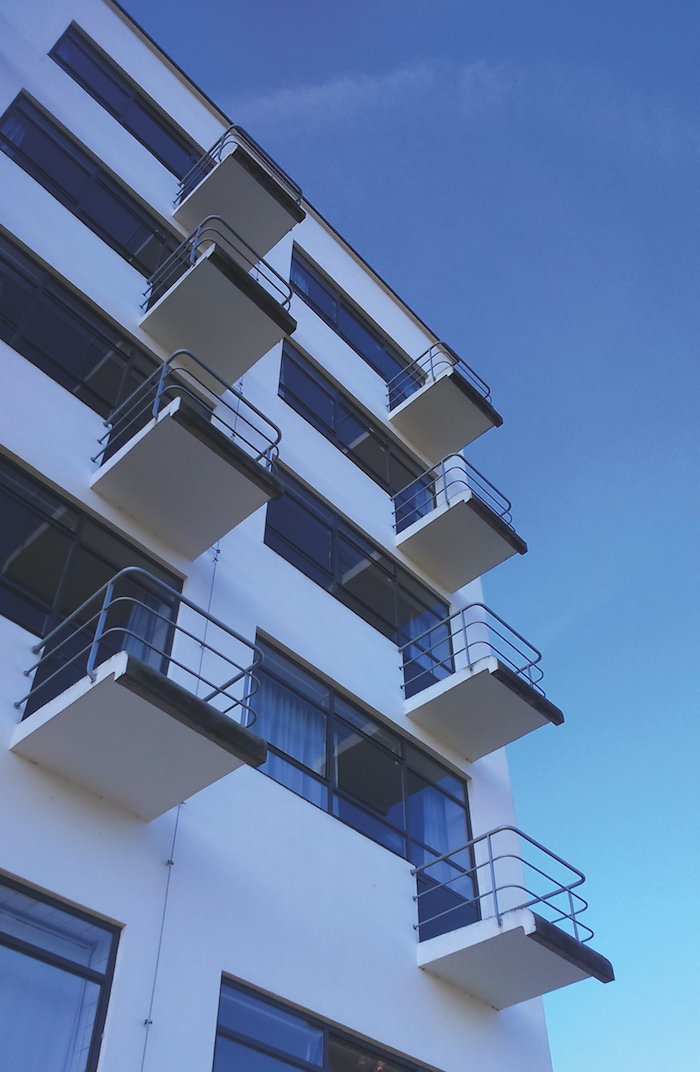Photos: Frances Ambler
In our late summer issue, we share four different stories of time travel. Frances Ambler wrote about what it was like to spend a night at the Bauhaus in Dessau, Germany.
"I was standing in front of the then ultra-modern building… Its architecture represented to me the beginning of a new era.” So wrote student Hannes Beckmann on arriving at the Bauhaus in Dessau. Walter Gropius designed the building to match this ambitious art school, a vision of soaring glass, proclaiming its own name in huge letters down its side. Its photograph was circulated around the world – at first a symbol of German creativity and forward thinking; later, after its closure by the Nazis, a symbol of a lost era.
As I stood there, in grey drizzle, it wasn’t quite living up to this promise. I was staying overnight in one of the 28 studio rooms where students had worked and slept, part of my research for my book, The Study of the Bauhaus. The room had the single bed, fitted cupboards and sink familiar from student halls – here, however, the furnishings revealed the creativity of its former inhabitants: the tubular metal furniture devised by Marcel Breuer seen in a set of nesting tables; the modernist patterns promoted by the weaving workshop present in a bedspread devised by Gunta Stölzl. Echoing the pattern of my own student life, I crawled into bed with my phone, distracting myself with the hum of contemporary online life.
If I went to bed in a 21st-century fug, I woke up in the optimism of the 1920s. Bright blue sky had taken the place of the grey. The huge desk by the window suddenly looked inviting. I stepped onto the balcony, and looked over the surrounding town in a new light.
The day opened up a Bauhaus experience bigger than the room: what had been the student canteen, auditorium and gym, the spaces where workshops once whirred with activity. On a tour, we stopped in one of the studio rooms, made up as it would have been then. It had belonged to Marianne Brandt, who had found her calling in the metal workshops, inventing lamps, ashtrays and her now-famous tea set, which today sell for thousands of pounds. It was right next door to the room where I’d spent the night.
Looking at Brandt’s record player, I understood my earlier disconnect. The many snapshots taken by the students themselves show them in and out of each others' rooms, leaning across their balconies and throwing impromptu parties – rows of cakes spread across the nesting tables, grinning attendees squished onto the single bed. They experimented and learnt together; they also gave friendship.
Right wing opponents forced the Bauhaus to close in Dessau in 1932, and it moved, temporarily, to Berlin before finally closing the following year. Its students spread out around the world. We tend to hear the names of the lucky ones, such as Josef Albers or Marcel Breuer, who forged new lives in America. Others struggled in Germany, their careers never reaching such dizzy heights. Some suffered in concentration camps. The building itself was damaged in bombing, only fully opening for visitors four years ago.
But the Bauhaus was always more than its building. It was about the people and their desire and determination to build a better world – a spirit that blazed as brightly as that day’s blue sky.
The Story of the Bauhaus is published on 11 October (Ilex Publishing). You can pre-order a copy here. And enjoy three other stories of time travel in our late summer issue.

